

Therefore, articles explaining the Prison Industrial Complex whilst bringing in surveys, statistics, and data are often the best form of education, leading to protest. Additionally, it was fascinating to survey my peers. One of the things I found the most interesting was that the majority of my classmates stated their belief that the goal of prison should be to punish. However, everyone surveyed over 18 believed that the goal of prison was to reform. I don't know exactly why that is, and I've been thinking about it constantly. The Business Model of Private Prisons. The U.S. prison system incarcerates approximately 2.3 million people as of 2020.1 These prisoners are there for a multitude of different crimes ranging from drug possession and petty larceny to grand theft auto and murder.
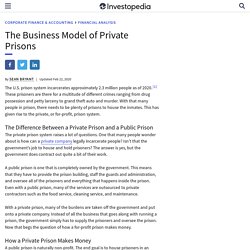
With that many people in prison, there needs to be plenty of prisons to house the inmates. This has given rise to the private, or for-profit, prison system. The Difference Between a Private Prison and a Public Prison The private prison system raises a lot of questions. One that many people wonder about is how can a private company legally incarcerate people? This Is How Private Prison Companies Make Millions Even When Crime Rates Fall.
<a href=" Let our journalists help you make sense of the noise: Subscribe to the Mother Jones Daily newsletter and get a recap of news that matters.
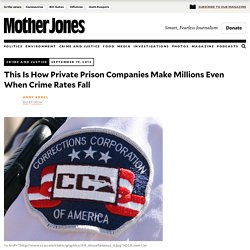
We are living in boom times for the private prison industry. The Corrections Corporation of America (CCA), the nation’s largest owner of private prisons, has seen its revenue climb by more than 500 percent in the last two decades. And CCA wants to get much, much bigger: Last year, the company made an offer to 48 governors to buy and operate their state-funded prisons.
But what made CCA’s pitch to those governors so audacious and shocking was that it included a so-called occupancy requirement, a clause demanding the state keep those newly privatized prisons at least 90 percent full at all times, regardless of whether crime was rising or falling. What Do Prisoners Make for Victoria’s Secret? Let our journalists help you make sense of the noise: Subscribe to the Mother Jones Daily newsletter and get a recap of news that matters.
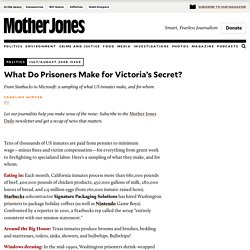
Tens of thousands of US inmates are paid from pennies to minimum wage—minus fines and victim compensation—for everything from grunt work to firefighting to specialized labor. Here’s a sampling of what they make, and for whom. Eating in: Each month, California inmates process more than 680,000 pounds of beef, 400,000 pounds of chicken products, 450,000 gallons of milk, 280,000 loaves of bread, and 2.9 million eggs (from 160,000 inmate-raised hens). Starbucks subcontractor Signature Packaging Solutions has hired Washington prisoners to package holiday coffees (as well as Nintendo Game Boys). Confronted by a reporter in 2001, a Starbucks rep called the setup “entirely consistent with our mission statement.” CORRECTIONS: Prison Privatization and the Prison Boom. Outlawed at the beginning of the 20th Century, private corporations are once again owning and operating prisons for profit.
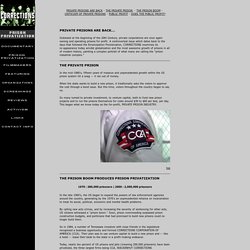
A controversial issue which dates back to the days that followed the Emancipation Proclamation, CORRECTIONS examines its re-appearance today amidst globalization and the most awesome growth of prisons in all of modern history, painting a complex portrait of what many are calling the "prison industrial complex. " In the mid-1980's, fifteen years of massive and unprecedented growth within the US prison system hit a snag -- it ran out of money. Masked Racism: Reflections on the Prison Industrial Complex. What is the Prison Industrial Complex?
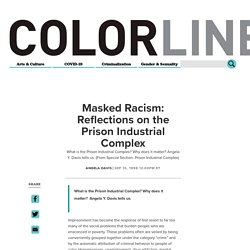
Why does it matter? Angela Y. Davis tells us. Imprisonment has become the response of first resort to far too many of the social problems that burden people who are ensconced in poverty. These problems often are veiled by being conveniently grouped together under the category “crime” and by the automatic attribution of criminal behavior to people of color. The Prison-Industrial Complex. Although indeterminate sentencing had many flaws, one of its virtues was that it gave the state a means of controlling the size of the prison population.
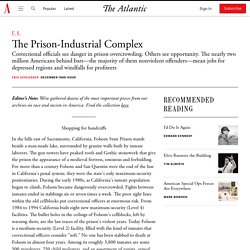
If prisons grew too full, the parole board could release inmates who no longer seemed to pose a threat to public safety. Governor Reagan used the Adult Authority to reduce the size of California's inmate population, giving thousands of prisoners an early release and closing one of the state's prisons. By the mid-1970s, however, the Adult Authority had come under attack from an unusual coalition of liberals, prisoners, and conservative advocates of law and order. Liberals thought that the Adult Authority discriminated against minorities, making them serve longer sentences.
What is the Prison Industrial Complex? – Tufts University Prison Divestment. As explained by abolitionist organization Critical Resistance, “the Prison Industrial Complex (PIC) is a term we use to describe the overlapping interests of government and industry that use surveillance, policing, and imprisonment as solutions to economic, social and political problems.”
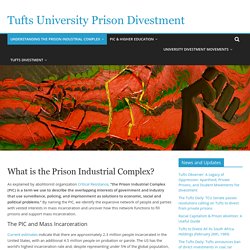
By naming the PIC, we identify the expansive network of people and parties with vested interests in mass incarceration and uncover how this network functions to fill prisons and support mass incarceration. The PIC and Mass Incarceration Current estimates indicate that there are approximately 2.3 million people incarcerated in the United States, with an additional 4.5 million people on probation or parole.